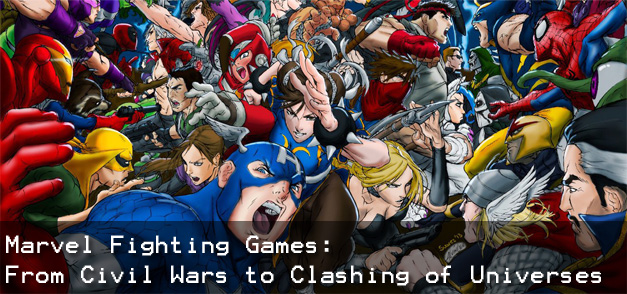
eSport tournaments such as EVO host a variety of fighting games every year, awarding large sums of cash to the winners who participate. And for EVO (which is the largest of these tournaments), the Marvel vs. Capcom series has been a staple for the show for nearly a decade straight with high ranking competitors such as Justin Wong taking part in.
Marvel vs. Capcom 2 is the first from the series to be played at EVO, and it lasted for many years until Marvel vs. Capcom 3 entered the scene in 2011, which was then quickly dropped in 2012 when the updated version Ultimate Marvel vs. Capcom 3 was released, and as of 2015 is still used for tournament play. But MVC2 and MVC3 are just the tip of the iceberg for this popular fighting game franchise. Its roots go way back.
Before the Marvel vs. Capcom crossover there were the Marvel fighting games that included characters exclusively found from the pages of Marvel comics. First was X-Men: Children of the Atom and with it came new features implemented in to the gameplay seen from other Capcom fighters like Super Street Fighter II Turbo and would be used as a starting point for building the foundation to the series we know today. But the tie between Capcom and Marvel doesn’t begin here. It goes slightly further back in time, and not with a fighting game, but for one of its related genres.
Relations with these two publishers would officially begin in 1993 when Capcom released The Punisher, an arcade brawler that stars, obviously, the Punisher and also Nick Fury. It’s one of the better -- and more brutal -- beat 'em ups that include a wealth of weapons to pick up and use on your foes like guns, knives, grenades, swords, and baseball bats. It uses Kingpin as the antagonist, who was the villain for the Punisher from the comics around the time the game hit arcades.
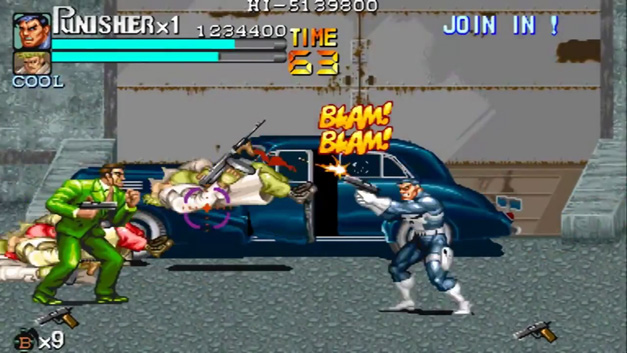
It makes sense for Capcom to first use the Marvel license as a brawler due to them churning out a new one every few months between 1990 and 1993. It was their specialty for the time. Fighting games were still fairly new for Capcom, so during that time we witnessed them experimenting on the genre with their own series, Street Fighter, as they made minor iterations to Street Fighter II with Champion Edition and Hyper Fighting. Post release of The Punisher, they would continue with more revisions like Super Street Fighter II and Super Street Fighter II Turbo.
It must have been around that time when Capcom decided they were comfortable enough with their experience with the genre to further expand into it. Odd saying this as they were the ones who basically made the genre wildly popular in the first place. They were just so reserved in making a true sequel to their knockout success, Street Fighter II. So during this time, Capcom’s output of fighters would increase three fold, hoping to make it as popular, or even more so, than their library of beat 'em ups; which is totally understandable as this was the era when the fighting game boom was in full effect. Arcades were packed with games like Midway’s Mortal Kombat series; SNK’s Neo Geo “big red” machines with fighters such as Samurai Shodown; and of course Street Fighter. Because of this, stating in 1994 Capcom would have three different fighting game series tied to their name: Street Fighter, Darkstalkers, and one based on characters from their good buddies over at Marvel.
For their second use of the Marvel license for arcades, they would build a fighting game based on the X-Men series, making great use for their new CPS-II board for arcade development. What came of this was X-Men: Children of the Atom, and with it the start of a new series for Capcom that would become an important pillar to their collection of fighting games for years to come. So let’s take a look and see Capcom’s use of the Marvel license for their fighting games which we’ll call the Marvel fighting series.
MARVEL ASSEMBLE!
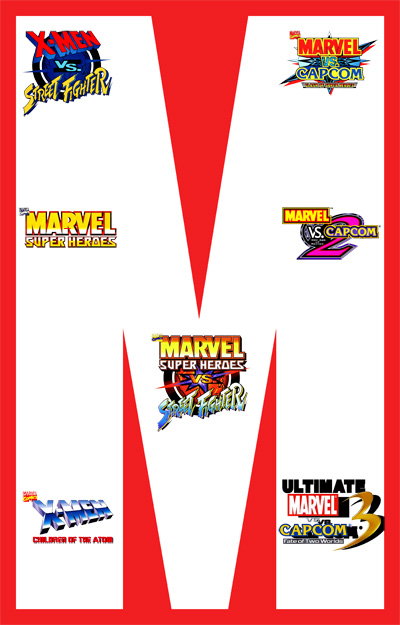

Released while the X-Men animated series was originally airing on television (which was a popular hit Saturday morning cartoon), Capcom released X-Men: Children of the Atom to arcades. This would be the first of many games Capcom would use from the Marvel license for the fighting game genre.
Capcom would do well with their use of the license by using their best resources to make one of the greatest looking 2D fighting games when it debuted. Character sprites were well animated and the backgrounds were chock-full of activity which really brought the game to life.
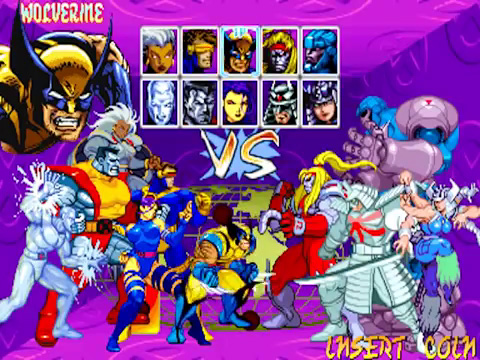
Introducing some new gameplay elements, COTA would be the first game to have super jumps, allowing characters to jump at least twice as high as a normal jump. In addition, some levels had tiered environments where you can knock an opponent to another location of the stage to fight on. It’s an incredibly great feeling when you slam an opponent with a super move onto a hidden area.
The roster allows you to choose not only the heroes from the X-Men franchise, but the villains as well. To keep in uniform with the TV show, they used the voice actors from the animated series to voice the characters in the game. Each character has a story, and COTA has to be the game with the best endings of the Marvel fighting games -- that is, if you can beat the game to view to them.
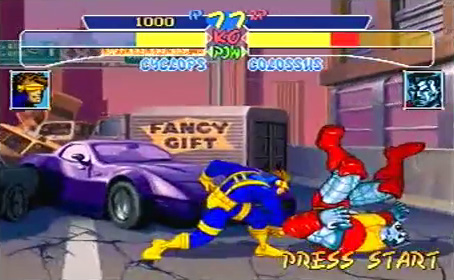
Seemingly the most difficult game, you’ll squeeze the controller in frustration many times over when you battle Magneto with his crazy super moves and combos (even on the easiest difficult setting). Even so, the combo systems you can create and the ability to perform aerial attacks all add points for COTA to make it a title worth noting. Ported to home consoles the years following its release to arcades in 1994, it’s a game worthy of using the Marvel license and is the intro for a soon-to-be loved fighting game franchise.

If X-Men: Children of the Atom were the entrée in the Marvel vs. banquet, then Marvel Super Heroes would be the first of the main courses.
With the license, not only are they using characters from the X-Men franchise, but characters throughout the Marvel universe. So not only are you seeing characters like Wolverine and Magneto, but others such as Captain America, Blackheart, and Doctor Doom.
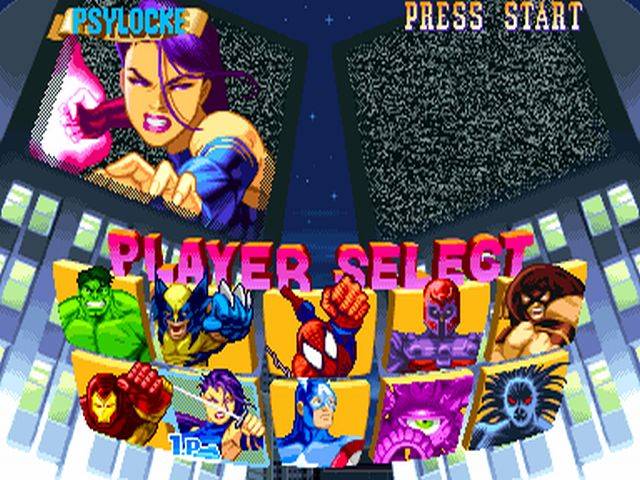
Introducing something unique at the time, the gameplay includes a new mechanic: Infinity Gems. These are items you can collect during each match by knocking them out of the opponent. Once obtained, you can use it to perform a temporary ability such as increasing your strength or recovering a portion of your health.
As you might have figured out with that new game mechanic, the story of the game is based on the The Infinity Gauntlet storyline where Thanos is trying to collect the Infinity Gems to use with his glove to create the Infinity Gauntlet; which gives the wielder great power. Speaking of which, the story endings for each character are worth watching and are a great incentive for finishing the game with every character. MSH also includes a number of hidden characters you can play with, too.
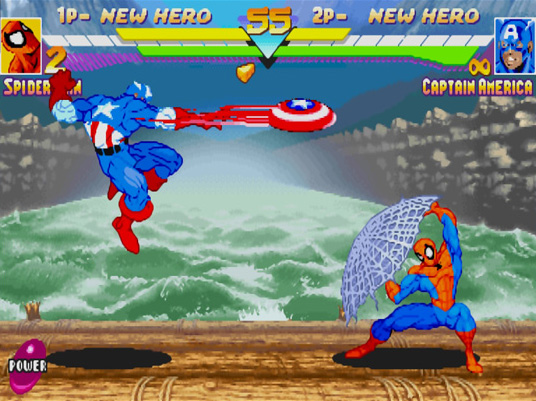
Marvel Super Heroes is vastly improved compared to its predecessor due to a number of factors including a progression on aerial attacks. To have achieved this, characters like Spider-Man and Iron Man were added to the roster which, not only perform some great combos while in air, but some like Iron Man can hover in mid-air for a while and stage air-to-surface type of attacks.
In all, Marvel Super Heroes is a well-rounded fighting game that is fun to play and incorporates a difficulty level that is challenging but fair. In progressing the series, MSH was a step in the right direction.

This is where things get interesting. First off, this would be the first title in the series to officially cross the Marvel and Capcom universes together. If you were at the arcades and saw the attraction screen where Ryu and Cyclops shake hands to team up against the forces of evil, your mind would have been blown.
Boasting a healthy 17 fighter roster, it’s nearly split down the middle with half being fighters from the X-Men and half from Street Fighter. For X-Men, there’s a mix of returning characters and new ones. New faces include Rogue, Gambit, and Sabretooth. For Street Fighter, it dips into the Alpha roster by having characters like Charlie and Cammy enter the fray. Of course you have old time favorites Ryu, Ken, and Chun-Li as well.
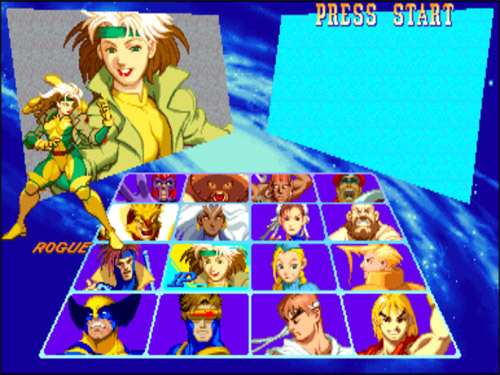
Differentiating itself from previous titles, X-Men vs. Street Fighter no longer has the traditional one-vs-one, three round styled matches. Instead, to complement the crossover, each side has two fighters and where there is only one round per match. This allows the player to select two characters to fight with. But when the match starts, it’s not a four person brawl. Instead, it becomes a tag team match where you can swap between your two fighters at any time. And for the one standing on the sideline, a partial recovery of their health bar can be performed.
The icing on the cake for this tag team styled battle system comes from the fact that you can call in your partner to help out when needed. The Variable Counter is when you can call your partner in to perform a quick attack in hopes to distract the opponent. But the dope way to call for your partner’s assistance is with a Variable Combination which has both fighters simultaneously executing their super moves. You can deal a lot of damage to your opponent and quickly turn the tides during a match with this little ace in the hole.
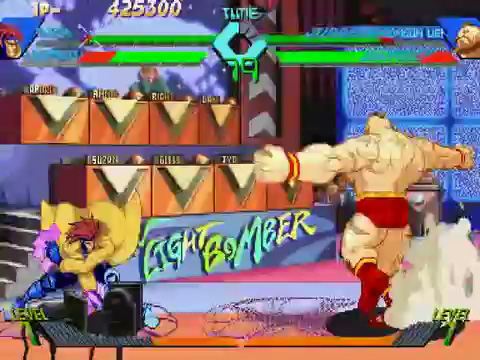
Home console versions of XSF were ported to the Saturn and PlayStation, but North America only received the inferior PlayStation version. For the Japan only Saturn copy, it’s an arcade perfect version which benefits when played with the 4MB RAM cart. Load times are at a minimum and gameplay is silky smooth. The PlayStation version suffers from a number of problems including the loss of sprites and frames, slowdown, and the removal of the tag team gameplay. Heinous!
Capcom was firing on all cylinders when they developed X-Men vs. Street Fighter. It added a lot of new mechanics to the series and it made it three-for-three in terms of successful titles. Seemingly unstoppable, could they do it again and make it a four-peat?

1997 was when the fourth installment for Capcom’s successful fighting series debuted in arcades (2nd if you only count the verses series). With it you get everything the previous game had to offer, but with improvements to make it more a more balanced system. Nonetheless, was it enough for it to be a full-fledged sequel? If you look online, mixed reactions from reviewers can be found with this title.
More like a version 2.0 for X-Men vs. Street Fighter, Marvel Super Heroes vs. Street Fighter took a smaller step towards evolving the gameplay compared to previous iterations for the series. Returning are features like the tag team play introduced from XSF and the Variable Combination attack, but with a twist where after the attack is performed, the fighter who was battling when the move was executed will not get swapped out with their partner. It’s a minor change when described but while playing it’s a pretty significant one.
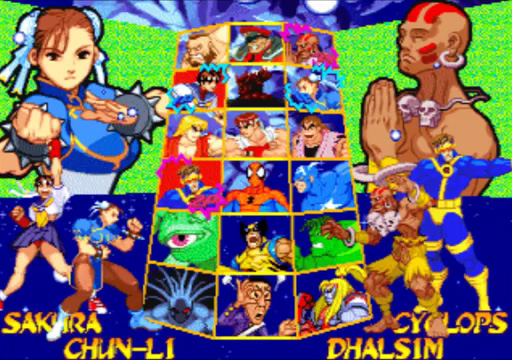
Infinite combos are a bit harder to come by as well. This helps with the game being more balanced and a preferred version when it comes to tournament play when compared to its predecessor. Balanced is further improved by the characters in the game.
Speaking of which, fighters from Marvel’s side are all who’ve you seen before. No one new has been added, but old familiars not seen since Children of the Atom will make a return like Omega Red. From the X-Men universe: Rogue, Gambit, Storm, Sabretooth, Juggernaut, and Magneto were all removed from the roster to make room for others found throughout Marvel’s catalogue. Meaning, returning from MSH are: Captain America, Spider-man, Hulk, Blackheart, and Shuma Gorath. On the other side, new for Capcom are Sakura and Dan. And if you played the Japanese version of the game, you’ll notice a fighter at the bottom of the character select screen who does not belong to either Capcom or Marvel.
I’m referring to Norimaro, an odd looking fellow who wears a Japanese school uniform and has a messenger bag slung over this shoulder. He’s the new Dan, a goofy character to pick who doesn’t quite fit in like the others, but unlike Dan, Norimaro has some devastating moves. He was omitted from the North American version of the game, bringing the list down from 18 to 17, matching the number of characters from XSF (not including secret characters which bumps the number up an additional six).
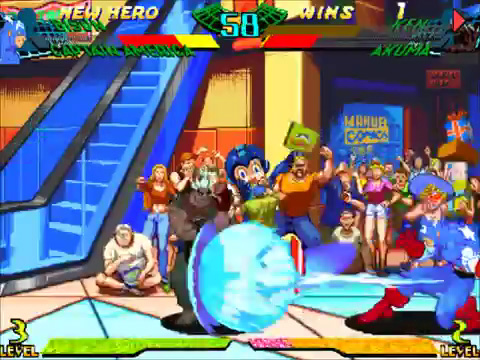
Another example for the 2.0 suggestion are the stages, which are modified versions from the ones found in XSF. Some are just day/night swaps, but one of the more impressive stages is the mall, which went from a desolate and dark place to a brightly lit area crammed full of spectators watching the fight, complete with a number of animations seen throughout; all of which was carried over to the Saturn version of the game, which again benefited with the 4MB RAM cart. And unfortunately again, America only received the inferior PlayStation version.
From all the games in the series, this would be the only one that doesn’t seem to have shined nearly as well as the others did. Not saying it’s a bad game -- far from it. But it was something we’ve already seen before. If to relate it to the Street Fighter series proper, it would have been labeled something like Super X-Men vs. Street Fighter or X-Men vs. Street Fighter Turbo. The “slump” would only be temporary as what came next would have fans at arcades eager to see what their little fighting franchise had evolved to.

Following the traditional annual release of fighting games featuring the Marvel license, 1998 is when the next iteration from Capcom appeared, and as expected, it too follows the familiar pattern of expanding outward by reaching for more and more characters spread throughout each side’s universe. But this would be the one that finally has a proper crossover between both of these publishers with their respected mediums of comics and video games.
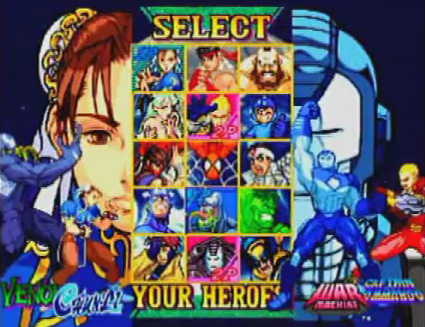
Marvel vs. Capcom: Clash of Super Heroes pulls in mostly the same characters as you’ve seen before from Marvel’s side in past games, with the exception of War Machine who is basically a palette swap of Iron Man, and new face Venom who is a new character but borrows a number of moves from Spider-man. Since the expansion this time is for Capcom’s side, this is where we see the bulk of newer characters.
Standing next to their Street Fighter brothers and sister (Chun-Li being the only returning female character) we have Morrigan from Darkstalkers, Jin from Cyberbots, and then Megaman, Strider Hiryu, and Captain Commando from each of their own series’ of titles. To round off Capcom’s side, Ryu and Zangief continue to stay in the roster’s lineup, bringing the count of fighters to 15. However, this doesn’t account for everyone who has made an appearance in MVC. Oh no, it’s way more.
New to the crossover games is having a third character on your side. As before in X-Men vs. Street Fighter and Marvel Super Heroes vs. Street Fighter, we have the tag team system, but built on top of that is getting a randomly selected third fighter to assist during a match. Unfortunately you can’t control these special third partners with the exception to call them in when needed. This group of special characters only assist, so you can’t select them to control during a match, but with 20 of these assist characters, the number of heroes seen in MVC balloons to 35!
A new fighting mechanic added to the mix is the incredibly wild Duo Team Attack (also called Variable Cross) which allows you to call in your partner and control both characters simultaneously for a short period of time. The bonus to this is it allows an unlimited use of Hyper Combos during this time, filling the screen with absolute madness by having psychedelic colors flow in the background and combos climb to insane numbers. The catch to this is it will drain the super meter to zero when finished.
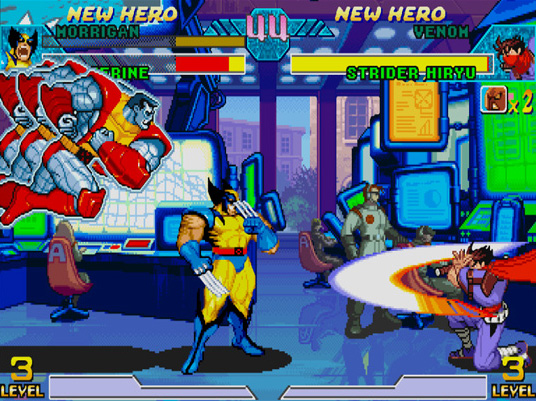
The game is balanced for the most part until you get to the final boss, Onslaught, who is crazy unfair. Being on par with Magneto from Children of the Atom, he will unleash a flurry of attacks one after another, pinning you to the corner of the screen until your fighters’ health meters dry up. The one-two punch comes from him spamming his Hyper Grab special to pull you into his attacks. However, there is a pattern to his attacks if you have a keen eye, so he’s not completely unfair like Magneto is, but he’s way more challenging than Apocalypse and Thanos were from previous games.
Congratulations go out to Capcom for finally achieving the true crossover the franchise always teased players with since the first appearance of a cameo from Akuma when he was seen in Children of the Atom. With Marvel vs. Capcom, there were no more restrictions on which characters to include from either universe. The possibilities were now wide open for anyone to join in on the fighting. And for the next game, Capcom would abuse this privilege to the max…but that’s a good thing.

It’s hard to surpass near perfection with Marvel vs. Capcom. It’s a game that encapsulates nearly every great feature seen throughout all of its predecessors like tag team fighting, aerial raves, assists, hypers, and the ability to select any character seen from both companies’ vast catalogues. But leave it to Capcom to blow pass their crowning achievement once again by doing just the opposite by making a complete mockery of having a balanced system and tearing it apart to shreds.
It’s hard to begin describing Marvel vs. Capcom 2 because so much has been added-on and modified to the gameplay mechanics. But for starters, the control scheme has changed, going from a traditional six button fighter down to a four button (in terms of attacks). Punch and kicks lost their medium attacks and were replaced with buttons used exclusively to call in your partners. Crazy that they lost the medium attacks, but that’s what this game is all about: crazy.
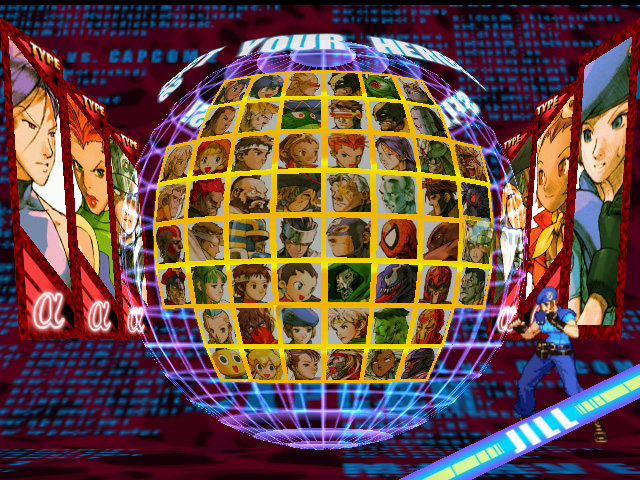
For the tag team system they added a third fighter, making it a three-on-three brawler. They did without the special character feature seen in MVC, and instead allowed players to pick three fighters and have the ability to control all three fighters during the match. So as MVC was used as a sample tasting for players to pick their ideal triple threat teams, MVC2 goes forward by executing on the idea. But for having six characters duking it out per match, you’d need a roster large enough to keep things interesting. This is covered as there are 56 fighters to pick from. That’s right, over 50! Nearly tripling what MVC had, and that was a lot!
At first glance the character select screen is overwhelming to look at. And because there are so many characters to pick from, each fighter’s profile is a teeny-tiny postage stamp sized image. But once a character has been chosen, each will also have an assist type assigned so they can perform a certain attacks like dashing in, anti-air, or projectile when called. Assist types are broken down into three categories to keep things simple: alpha (α), beta (β), or gamma (γ). Allowing the player to pick the assist type for their fighters adds a layer of strategy to the game.
The hyper combo system has been modified a lot. Duo Team Attack has been removed, but in its place comes Delayed Hyper Combo. This handy feature allows three hyper combos to be performed in a row, creating a chained combination from all three of your fighters. But you still have the option to execute all three simultaneously, unleashing absolute chaos and racking up a huge chain combo that can be in the hundreds! To allow three character hypers, the hyper combo gauge goes up to five levels, allowing you to either use them sparingly or use them all up in a few chained moves.
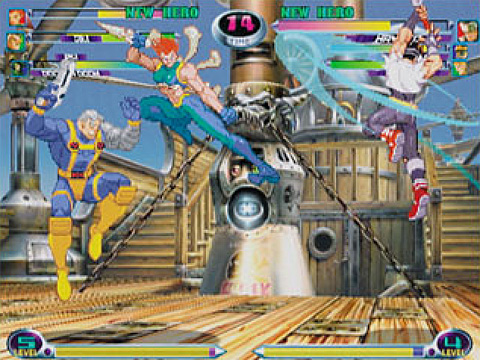
Comparing the gameplay to previous titles, this one is in turbo mode. It’s all about chained combos and juggling your opponent in the air mercilessly. You are given 99 seconds to defeat a team of three, and it will take many chained combos and a few hypers to destroy all three within the allotted time. If you are jumping in from a previous installment like Marvel Super Heroes vs. Street Fighter then get ready for a serious wakeup call as you’ll be getting many time overs until you adjust to the higher speed in gameplay. And for a first, there is no option for selecting easy mode where your character automatically blocks for attacks. Truly, the training wheels have been removed, giving no mercy by having no handicaps included for new comers to the series.
MVC2 is very impressive and it’s all thanks to a new engine the game is built on. This would be the first game in the Marvel fighter series to not use the CPS-II system and instead be on Sega’s latest arcade board, NAOMI. With this new tech they were able to add more assets to the game. The biggest change visually would be the graphics. Here we can see Capcom’s fad for the time by having 2D sprites in front of polygonal 3D background stages. In addition, the music for many of the stages include vocals in them. This was good, but the soundtrack has mixed opinions due to its Jazzy style. It was nice to have the soundtrack not be another remix of tracks for each character, but Jazz? Come on!
With just about every character included in MVC2, from the origins with Children of the Atom all the way to MVC, aaannnd with the inclusion of new characters seen in MVC2, it is a title worthy for its high praises. Sure it’s an unbalanced mess, but if even tournament level players can see past the flaws, then that goes to show just how great this game is. Good thing, too, because for the next installment, it would be a very long time till we would see a successor to MVC2.

11 years. 11 years is how long it took for Capcom to get together again with Marvel to create a follow-up to their very successful fighter series. Between 2000 and 2011, a lot had changed in gaming, and as well for the fighting genre. With MVC2, it debuted during the dawn of a new console generation where online console gaming was just starting to grow legs. For Marvel vs. Capcom 3, it came out after that console generation had long past and the following generation was entering its twilight years where online console gaming was common place for nearly half a decade. The time was right as there was no arcade release for MVC3, so online play would be an absolute necessary when it came to multiplayer challenges.
Marvel grew exponentially as well during this time by leaping off the pages of comics and onto the silver screen, making summer blockbuster films year after year staring in the year 2000 with X-Men, which was only a few months after MVC2 hit arcades and following with the Dreamcast. Afterwards, they expanded on their catalog by making films for their other properties like Spider-Man, Iron Man, and then later with The Avengers, where it encapsulates a number of characters into one story. Hey! See a parallel with their films to the evolution of the Marvel fighter series?
Anyways, MVC3 wouldn’t be an all-out zany thing like its predecessor. They would dial the roster back a bit to 36 characters. Far from what they had before but still a good number to choose from. Since a long time had passed, many new games and franchises came out while the Marvel vs. Capcom series was in a slumber. For Capcom, we saw new characters like Amaterasu from Okami, Dante and Trish from Devil May Cry, Crimson Viper from Street Fighter IV, and Viewtiful Joe from…Viewtiful Joe. For Marvel, new characters added to the series include (but not limited to) X-23, She-Hulk, MODOK, Thor, and Deadpool.
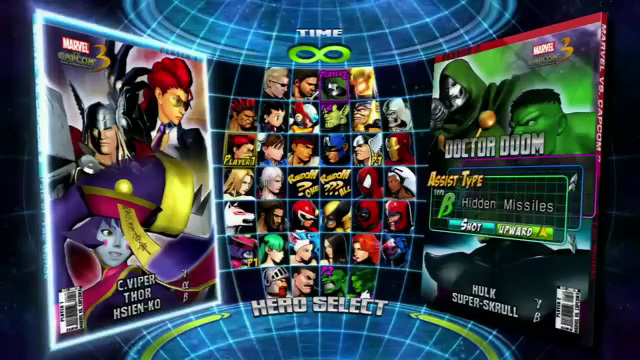
Since the game was designed for home consoles and not arcades, its control scheme was finely tuned for controllers instead of the tradition where the controls for home ports were forced to fit with to their arcade counterparts. Because of this, modifications were made for controlling your fighters, and if going down from six buttons of attack to four was weird with MVC2, then going down to three is absolutely nuts!
If using the PS3 controller, square is for light attacks, triangle is for medium attacks, and circle is for heavy attacks. To determine whether you want a kick or a punch depends on the stance -- standing is reserved mainly for punches while crouching is for kicks. The cross button, used for special attacks, is for moves like sending you opponent into the air or for executing aerial team combos or counters. And while the three button attack control scheme may sound weird, it actually works well by helping to streamline character specials and hypers.
As its core, it is still a three-vs-three tag based fighting game. And as before, each character you select for your team has an assist type you assign between the alpha, beta, and gamma markings. But gone are the options to select Normal or Turbo mode for play. And because of this, these unique settings that have been included in the character select screen since the beginning for the Marvel fighting series are now gone. No more selecting between Manual or Easy, and Turbo or Normal. But that’s ok, because as noted before, this game is designed for streamlining the experience.
A new add-on for the series is the X-Factor, which when activated, gives your team a temporary boost in speed and strength. It varies from character to character and how many fighters remain on your team, but it’s a great way to make a comeback if you’re on the ropes. Team Aerial Combos, similar to Team Hyper Combos, have each fighter in your team perform a special move one after the other while in the air -- even when your special meter is empty. A few other features introduced in MVC2 return like Team Hyper Combos (previously called Delayed Hyper Combo), Snap Backs, and the ability to either call in a partner to assist or to tag them in with just one button.
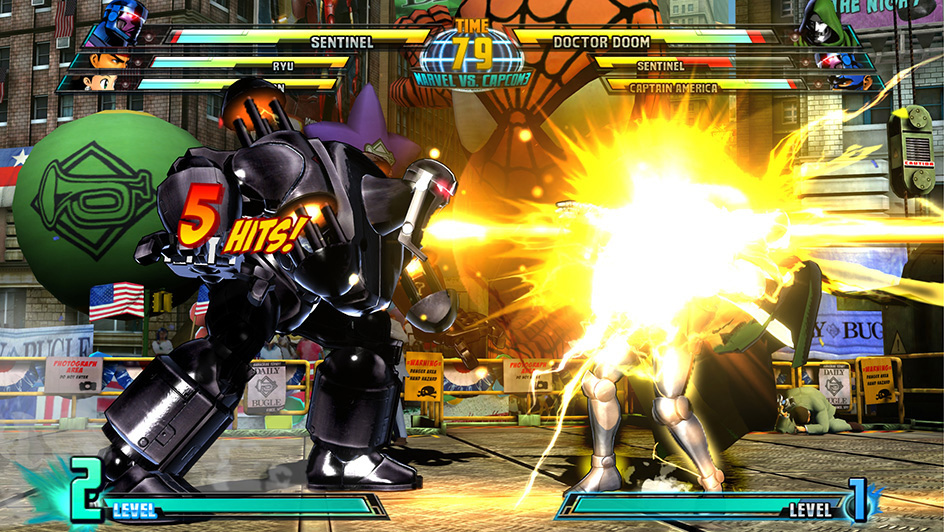
Of course since it’s been over ten years since the last game, a new engine was used for its foundation. Capcom’s own MT Framework engine was given top choice to bring the series to full 3D. No more character sprites were used, so every fighter had to be redrawn for MVC3. Because of this, it follows in the footsteps of Street Fighter IV where we have a fighting game in fully polygonal 3D, but still plays in the same way as a 2D fighter. As the leader for the game, Ryota Niitsuma, who previously worked not only on SF4, but also Tatsunoko vs. Capcom, worked as Producer on MVC3. With this, he took what he learned from those two experiences and put them towards making MVC3 and adding to it what was seen in MVC2. This was probably the best way to make a follow-up to one of the most favorite fighting games of all time.
The presentation is fantastic and really has a great comic book vibe to it. Heck, transitions are seen as someone flipping through the pages of a comic book. For the characters, they have dark contrasts where shadows are inky black and the lighted areas are vibrant and colorful. They even have an ink outline around them, adding to the comic book look. As a comparison, the character models look similar to the character art seen in X-Men: Children of the Atom.
When considering all that the gameplay has to offer in terms of new features, and keeping with that familiar feeling the previous game left with players, it’s a fantastic fighting game. But unfortunately not everything in the garden of MVC3 is rosy. Online play was told by many to be unstable and lacked features seen from other recent Capcom fighters like SF4. In addition, even though character stories have returned (MVC2 did not have a story), the endings were lackluster and only had two still images used for endings. This was a missed opportunity to make cool animated shorts like in SF4, or better yet, have an animated comic book styled cutscene, similar to what was seen in Metal Gear Solid: Peace Walker. That would have fitted nicely.
Then to everyone’s surprise, after it took a decade plus to see a new installment between MVC2 and MVC3, a follow-up came less than a year later when Ultimate Marvel vs. Capcom 3 hit retail shelves.
Similar to Marvel Super Heroes vs. Street Fighter, where it was like a 2.0 version of X-Men vs. Street Fighter, Ultimate Marvel vs. Capcom 3 is a shadow of its predecessor. With it we get a few stages that have been slightly modified so to give a different vibe like switching the scene from day to night, minor tweaks made for balancing the gameplay, and new characters added to the roster. All of it is just enough to warrant a follow-up rather than be a number of system updates or add-ons via DLC.
Considering the roster, with 12 new fighters entering the mix, the count climbs to a total of 48 (50 if you add the DLC characters Jill Valentine and Shuma-Gorath). For a fighting game, that’s quite a healthy selection to pick from, especially for a three-on-three fighter; although, about half the newcomers were pretty weak sauce. The beefy, stiff guys like Ghost Rider and Nemesis are fun to play but a few like Phoenix Wright and Firebrand can be seen as the new Roll and Dan. But in terms of variety, this is a great batch.
While the gameplay and character model assets are all the same from MVC3, we do get a new presentation wrapped around the game. The menus are all new and the visuals of flipping through the pages of a comic book is used more than before; we get slight remixes to some of the music; and different movies for the intro and credits. If you played both games, you’ll notice some of the endings are slightly different. With UMVC3, they’re more like abridged versions. Weird but true.
We recently passed the 20th anniversary of when the Marvel fighting series began, and following it a solid collection of fighting games. And with each release, Capcom took another step forward in pushing the boundaries outward, adding more characters by expanding on Marvel’s deep well of superheroes and villains. When you thought they hit a wall, they clashed worlds and turned it into a versus series by having their own characters go toe-to-toe with Marvel’s, making one of the best East meets West collaborations of all time.
But the future unfortunately seems bleak for the series. As Marvel moves more towards center stage and becomes a shining light for American pop culture, the more it will want to control its properties. This could hinder any future Marvel vs. Capcom games as control might be so tight that it might not be in Capcom’s best interest to make a new game. And with the use of the Marvel license being so limited now a days, we’ve seen content quickly come and go. For example, the digital only re-release of Marvel vs. Capcom 2 hit XBLA and PSN in 2009, but was pulled in 2013 when the license expired. The compilation Marvel vs. Capcom Origins had an even shorter life when it was released in 2012 and then removed in 2014. And for UMVC3, all DLC, which included some characters, were all pulled from digital stores when the license expired in 2013.
But through all that time, from the nearly 100 characters that appeared in the series, only one can be seen across all 8 games. With Wolverine, who is like the Ryu of Marvel, greeted us in Children of the Atom and stayed all the way up to and including Ultimate MVC3; so in line with his comic book narrative, he transcends time. But it seems like an accident as it appears that Capcom wanted Cyclops to take top billing. If you look at the box art for each game (with the exception of Marvel Super Heroes) he starts in the center but slowly gets shuffled to the side until he’s pushed out of the picture -- and games -- all together.
While the continuation of the series looks bleak, eSports leagues like EVO and the Capcom Cup help keep the spirit of series alive and well. And if you need proof, check out the online streams of these tournaments to see the thousands of spectators cheer players as they show off their skills with UMVC3.
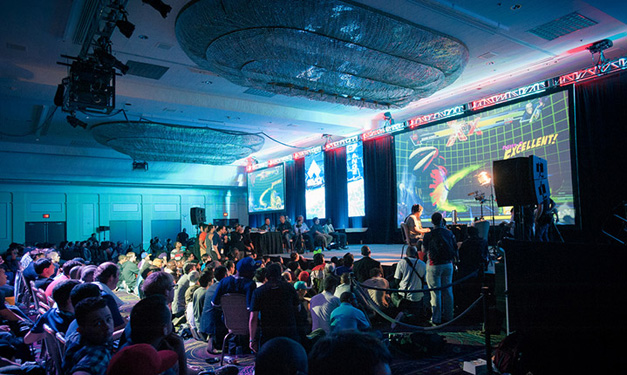
Image credits: Capcom, TechMynd, JustNoPoint, DeviantArt
Posted on: February 24, 2016

